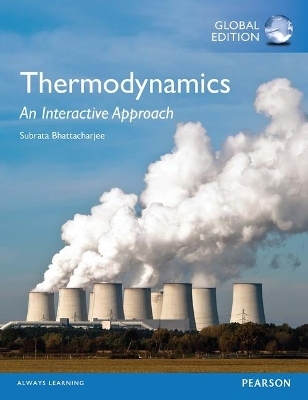
Thermodynamics: An Interactive Approach with MasteringEngineering, Global Edition
Pearson Education Limited
978-1-292-11384-5 (ISBN)
- Keine Verlagsinformationen verfügbar
- Artikel merken
Teaching and Learning Experience To provide a better teaching and learning experience, for both instructors and students, this program will: *Personalize Learning with Individualized Coaching: MasteringEngineering emulates the instructor's office-hour environment using self-paced individualized coaching. *Introduce Fundamental Theories Early: A layered approach introduces important concepts early, and progressively refines them in subsequent chapters to lay a foundation for true understanding. *Engage Students with Interactive Content: To create a rich learning experience for today's thermodynamics student, this book melds traditional content with web-based resources and learning tools. MasteringEngineering should only be purchased when required by an instructor. Please be sure you have the correct ISBN and Course ID. Instructors, contact your Pearson representative for more information.
0. Introduction Thermodynamic System and its Interactions with the Surroundings
0.1 Thermodynamic Systems
0.2 Test and Animations
0.3 Examples of Thermodynamic Systems
0.4 Interactions Between The System and its Surroundings
0.5 Mass Interaction
0.6 Test and the Daemons
0.7 Energy, Work, and Heat
0.7.1 Heat and Heating Rate (Q, Q)
0.7.2 Work and Power (W, W#)
0.8 Work Transfer Mechanisms
0.8.1 Mechanical Work (WM, W#M)
0.8.2 Shaft Work (Wsh, W#sh)
0.1.5 Electrical Work (Wel , Wel#)
0.8.3 Boundary Work (WB, W#B)
0.8.4 Flow Work (W#F)
0.8.5 Net Work Transfer (W#, Wext)
0.8.6 Other Interactions
0.9 Closure
1. Description of a System: States And Properties
1.1 Consequences of Interactions
1.2 States
1.3 Macroscopic vs. Microscopic Thermodynamics
1.4 An Image Analogy
1.5 Properties of State
1.5.1 Property Evaluation by State Daemons
1.5.2 Properties Related to System Size (V, A, m, n, m # , V#, n # )
1.5.3 Density and Specific Volume (r, v)
1.5.4 Velocity and Elevation (V, z)
1.5.5 Pressure (p)
1.5.6 Temperature (T)
1.5.7 Stored Energy (E, KE, PE, U, e, ke, pe, u, E#)
1.5.8 Flow Energy and Enthalpy (j, J#, h, H#)
1.5.9 Entropy (S, s)
1.5.10 Exergy (f, c)
1.6 Property Classification
1.7 Evaluation of Extended State
1.8 Closure
2. Development of Balance Equations for Mass, Energy, and Entropy: Application to Closed-Steady Systems
2.1 Balance Equations
2.1.1 Mass Balance Equation
2.1.2 Energy Balance Equation
2.1.3 Entropy Balance Equation
2.1.4 Entropy and Reversibility
2.2 Closed-Steady Systems
2.3 Cycles—a Special Case of Closed-Steady Systems
2.3.1 Heat Engine
2.3.2 Refrigerator and Heat Pump
2.3.3 The Carnot Cycle
2.3.4 The Kelvin Temperature Scale
2.4 Closure
3. Evaluation of Properties: Material Models
3.1 Thermodynamic Equilibrium and States
3.1.1 Equilibrium and LTE (Local Thermodynamic Equilibrium)
3.1.2 The State Postulate
3.1.3 Differential Thermodynamic Relations
3.2 Material Models
3.2.1 State Daemons and TEST-Codes
3.3 The SL (Solid>Liquid) Model
3.3.1 SL Model Assumptions
3.3.2 Equations of State
3.3.3 Model Summary: SL Model
3.4 The PC (Phase-Change) Model
3.4.1 A New Pair of Properties—Qualities x and y
3.4.2 Numerical Simulation
3.4.3 Property Diagrams
3.4.4 Extending the Diagrams: The Solid Phase
3.4.5 Thermodynamic Property Tables
3.4.6 Evaluation of Phase Composition
3.4.7 Properties of Saturated Mixture
3.4.8 Subcooled or Compressed Liquid
3.4.9 Supercritical Vapor or Liquid
3.4.10 Sublimation States
3.4.11 Model Summary—PC Model
3.5 GAS MODELS
3.5.1 The IG (Ideal Gas) and PG (Perfect Gas) Models
3.5.2 IG and PG Model Assumptions
3.5.3 Equations of State
3.5.4 Model Summary: PG and IG Models
3.5.5 The RG (Real Gas) Model
3.5.6 RG Model Assumptions
3.5.7 Compressibility Charts
3.5.8 Other Equations of State
3.5.9 Model Summary: RG Model
3.6 Mixture Models
3.6.1 Vacuum
3.7 Standard Reference State and Reference Values
3.8 Selection of a Model
3.9 Closure
4. Mass, Energy, and Entropy Analysis of Open-Steady Systems
4.1 Governing Equations and Device Efficiencies
4.1.1 TEST and the Open-Steady Daemons
4.1.2 Energetic Efficiency
4.1.3 Internally Reversible System
4.1.4 Isentropic Efficiency
4.2 Comprehensive Analysis
4.2.1 Pipes, Ducts, or Tubes
4.2.2 Nozzles and Diffusers
| Erscheint lt. Verlag | 10.12.2015 |
|---|---|
| Verlagsort | Harlow |
| Sprache | englisch |
| Maße | 220 x 275 mm |
| Gewicht | 1565 g |
| Themenwelt | Naturwissenschaften ► Physik / Astronomie ► Thermodynamik |
| Technik ► Maschinenbau | |
| ISBN-10 | 1-292-11384-7 / 1292113847 |
| ISBN-13 | 978-1-292-11384-5 / 9781292113845 |
| Zustand | Neuware |
| Haben Sie eine Frage zum Produkt? |